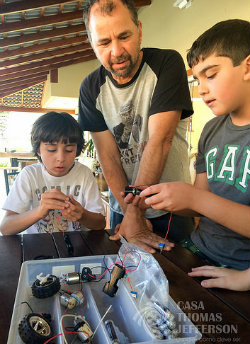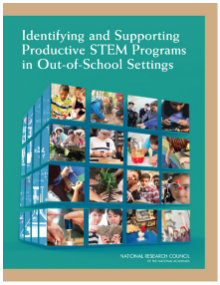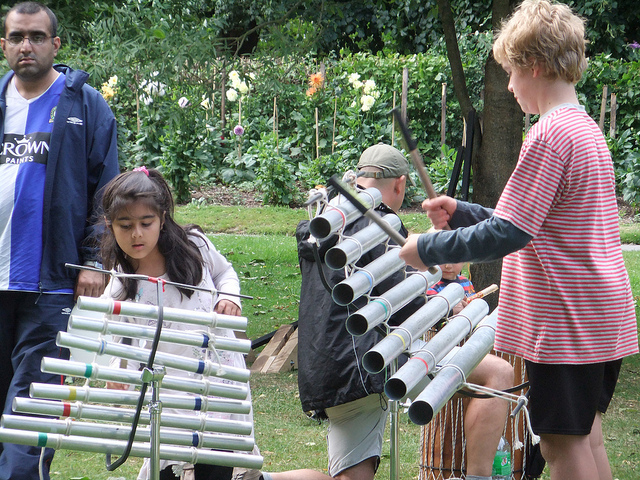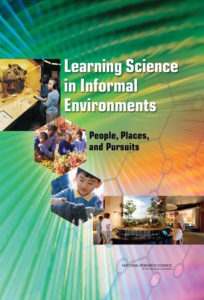Informal STEM Learning Has Big Positive Impact
A MiddleWeb Blog
 As an elementary-age child, I was fascinated and excited by a collection of fossils and minerals that a local geologist kept in his home. When I visited (as frequently as I could) he showed me fluorescent rocks that shone like multicolored fireworks in the dark.
As an elementary-age child, I was fascinated and excited by a collection of fossils and minerals that a local geologist kept in his home. When I visited (as frequently as I could) he showed me fluorescent rocks that shone like multicolored fireworks in the dark.
He took me back in time to treks with dinosaurs and Woolly Mammoths as I viewed their remains and listened to his stories about them. My time spent in this out-of-school setting sparked my lifelong fascination with science and STEM.
I don’t define STEM education solely by what happens in the classroom. In fact, students may have more opportunities to come across science, technology, engineering, and math out of school than in school.
And when kids encounter STEM in different settings and at other times, it reinforces their learning and tends to stick. What happens outside the classroom directly enriches what happens at school.
Consider this: if kids don’t use and appreciate STEM fields by the time they leave middle school, then chances are they never will. A large national survey in 2016 showed than 78 percent of children reported a positive experience with STEM subjects because of an after-school program or an experience outside the classroom.
With that in mind, here’s my equation for today’s middle schoolers:
Where and when does informal learning occur?
We usually refer to STEM-related learning that occurs in out-of-school contexts as Informal STEM Education. These contexts vary widely – from visiting science centers to watching a science program on TV. The common denominator across these programs is engaging, hands-on learning in a relaxed environment.
Education and business leaders in some communities are making determined efforts to identify, diversify, and connect young people’s STEM learning opportunities across the local landscape. The book Learning Science in Informal Environments (free for download from the National Academies Press) discusses four types of informal learning settings:
-
- Everyday experiences that occur over a lifetime, such as family activities, hobbies, technology use, and exploring and interacting with the natural world.
Designed spaces such as museums, science, centers, zoos, aquariums, and environmental centers that promote students pursuing STEM interests, engaging in inquiry, and discussing experiences with others.
- STEM programs that take place in schools and community organizations. These may include afterschool programs, organized clubs, camps, library activities, contests and competitions, field trips, and other events such as meetings with guest speakers and activities led by STEM enthusiasts.
- Science media (radio, TV, the Internet, digital devices) that make STEM information increasingly available to kids. Strong evidence suggests that this has an impact.
Summer programs and activities with a STEM twist can certainly meet the definition of “informal environment,” whether they are community-sponsored or closer to home. My recent STEM By Design newsletter includes LOTS of resources that can enrich informal STEM learning and reduce “summer learning loss.”
After-school STEM Programs
Since informal learning features big pluses, let’s look at one informal learning setting – after-school programs – in more detail. (Did you know that, according to the Afterschool Alliance, only 1 family in 3 who wants an after-school experience for their children has access to such programs?)
After-school programs provide some especially strong advantages. They typically take place at the school site so that kids don’t need transportation to get there. The same kids return each day and can engage in a STEM activity over an extended time period. After-school programs generally offer structured learning activities and are often coordinated with what the students are learning in school.
What would an after-school STEM program look like, ideally? That would be best determined by deciding on the outcomes you want for your kids. As an after-school STEM teacher or provider, you have an opportunity to do several things that will have lasting value for them. You can increase their interest and excitement in STEM learning, as well as their understanding and competence in STEM areas. You can help them build life skills such as creativity and innovation, collaboration, and critical thinking. You can equalize opportunities for diverse student groups.
Check out information from existing programs. California has an extensive online STEM Program Planning Tool that can guide your thinking as you plan and prepare. This tool also has a wealth of resources to help you get started. The website 4-H Science in Urban Communities has a checklist that you can modify for use with your STEM after-school program.
After-school curriculum
If you need a curriculum for an after-school program, I suggest you check out Engineering is Everywhere, from the Boston Museum of Science for terrific, well-developed middle school STEM lessons. This curriculum is also great for camps and clubs and summer activities with parents.

Makerspaces are increasingly popular as after-school programs that provide creative environments for exploration and possibilities. You can get a look at what some schools are doing with Makerspaces at Bob Pearlman’s site. Also visit Maker Ed. Click on their Resource Library for a selection of ideas and other helpful sites. Finally, download the useful Maker Ed‘s Makerspace Playbook for program development ideas.
Technology and coding are both popular choices if students have access to computers. Check out Codecademy and determine if this might be a useful site for your students. CODE is a user-friendly site that teachers (and others) can use to understand and learn coding.
Planning guide
For a more concise look at what informal STEM education can accomplish, take a look at this planning guide sourced from my book website.
Also remember that informal STEM programs are ideally developed through community-educator partnerships. Wherever possible, they should be rooted in real problems that have consequences for community members.
Arm yourself with knowledge and necessary tools for an exciting informal STEM education program and give your kids positive creative experiences to build their STEM interest and skills.
Feature image source
































